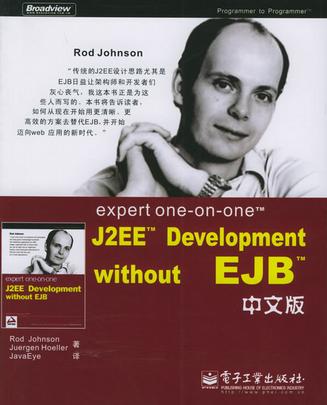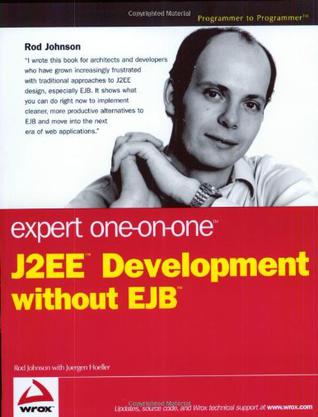欢迎来到相识电子书!
标签:springframework
-
expert one-on-one J2EE Development without EJB 中文版
乍一看这本书的名字,Expert one on one J2EE development without EJB并没有给人带来太冲击。毕竟关于J2EE的书太多了,而without EJB看上去有点象是故意挑衅EJB的感觉。一本J2EE的书怎么可能会给人带来信念或思维的冲击呢?但是它做到了,它不仅使自己变成了不朽的经典,也使Rod Johnson成为了我最近一年的新偶像。 --xiecc 你的J2EE项目是否耗费了你太多的时间?它们是否难以调试?它们是否效率不彰?也许你还在使用传统的J2EE方案,然而这种主案太过复杂,而且并非真正面向对象。这里的很多问题都与EJB有关:EJB是一种复杂的技术,但它没有兑现自己曾经的承诺。 在这本实战手册中,你将看到另一种截然不同的方案:没有EJB,却可以创建质量更高的应用程序,所需的时间和成本则更低。你将学会如何充分利用各种实用的技巧和工具,包括时下流行的Spring框架和Hibernate两个开源工具。你将看到如何高效地解决企业级应用的核心问题,例如事务管理、持久化、远程调用和web设计。你将了解这种新的方案给可测试性、性能和可伸缩性带来怎样的影响,并亲身体验轻量级架构如何大幅降低项目开发所需的时间和工作量。 自从servlet、EJB、JSP等J2EE技术发布之初,本书作者Rod Johnson就一直在使用这些技术,他对于这些技术的优劣利弊了如指掌。现在,通过这本书,你将可以面对面地分享他的专家经验。 你将从本书学到…… 如何针对自己的应用程序找到最简单、最易维护的架构;在不使用EJB的情况下有效地管理事务;如何利用AOP和loC解决企业级软件开发中的常见问题;web层设计,以web层在设计良好的J2EE应用中的地位;J2EE应用中最有效的数据访问技术,包括JDBC、Hibernate和JDO;如何利用开源产品提升生产率、减少编码量;如何从设计层面上改善性能和可伸缩性。 “传统的J2EE设计思路尤其是EJB日益让架构师和开发者们灰心丧气,我这本书正是为这些人而写的。本书将告诉读者,如何从现在开始用更清晰、更高效的方案去替代EJB,并开始迈向web应用的新时代。” 这本书拥有一大堆“看点”。譬如说,它的作者Rod Johnson拥有10年编写Java程序的经验,目前是Servlet和JDO 2.0两个JSR专家组的成员;再譬如说,书中着力介绍的Spring、Hibernate、WebWork等都是时下流行的开源框架,IoC、AOP之类都是时下流行的概念词汇。而最大的看点就赫然摆在这本书的封面上:“without EJB”。我们曾经在无数的书籍和文章中看到,EJB是J2EE的核心技术之一;而Rod Johnson的这本书竟然宣称,绝大多数的J2EE应用根本不需要EJB。这种近乎挑衅的姿态令任何一个负责的J2EE架构师很难不萌生一探究竟的念头——不论你是打算赞同他还是打算驳斥他。 但所有这些尽皆不是本书最大的价值所在。选择一种架构、一种技术的依据是什么?Rod Johnson认为,应该是基于实践的证据、来自历史项目或亲自试验的经验,而不是任何形式的偶像崇拜或者门户之见。书中谈到了企业应用方方面面的问题和解决办法,而这些方案无一不是这种“循证方法”的产物。除了把这些方案交给读者,Rod Johnson通过这本书希望传达的、更为重要的信息正是“循证”的工作方式——那原本就应该是程序员的工作方式。 -
Expert One-on-One J2EE Development without EJB
What is this book about? "Expert One-on-One J2EE Development without EJB" shows Java developers and architects how to build robust J2EE applications without having to use Enterprise JavaBeans (EJB). This practical, code-intensive guide provides best practices for using simpler and more effective methods and tools, including JavaServer pages, servlets, and lightweight frameworks. What does this book cover? The book begins by examining the limits of EJB technology - what it does well and not so well.Then the authors guide you through alternatives to EJB that you can use to create higher quality applications faster and at lower cost - both agile methods as well as new classes of tools that have evolved over the past few years. They then dive into the details, showing solutions based on the lightweight framework they pioneered on SourceForge - one of the most innovative open source communities. They demonstrate how to leverage practical techniques and tools, including the popular open source Spring Framework and Hibernate.This book also guides you through productive solutions to core problems, such as transaction management, persistence, remoting, and Web tier design. You will examine how these alternatives affect testing, performance, and scalability, and discover how lightweight architectures can slash time and effort on many projects. What will you learn from this book? Here are some details on what you'll find in this book such as: how to find the simplest and most maintainable architecture for your application; effective transaction management without EJB; how to solve common problems in enterprise software development using AOP and Inversion of Control; Web tier design and the place of the Web tier in a well-designed J2EE application; effective data access techniques for J2EE applications with JDBC, Hibernate, and JDO; how to leverage open source products to improve productivity and reduce custom coding; and, how to design for optimal performance and scalability.
热门标签
下载排行榜
- 1 梦的解析:最佳译本
- 2 李鸿章全传
- 3 淡定的智慧
- 4 心理操控术
- 5 哈佛口才课
- 6 俗世奇人
- 7 日瓦戈医生
- 8 笑死你的逻辑学
- 9 历史老师没教过的历史
- 10 1分钟和陌生人成为朋友


